Question 1. Histology of cartilage
Answer:
Cartilage is a modified connective tissue
- Histology of cartilage It consists of
- Cartilage cells called chondrocytes
- They are widely separated
- They lie in spaces called lacunae
- Initially
- Cells are small & active
- Nucleus is euchromatic
- Cartilage cells called chondrocytes
Read And Learn More: BDS Previous Examination Question And Answers
-
-
-
- Consists of prominent cell organelles
- Later
- Cell enlarges & becomes inactive
- Nucleus is heterochromatic
- Cell organelles are less prominent
-
- Matrix
- It consists of homogeneous ground substance within which fibres are embedded
- Ground substance
- It consists of complex molecules containing proteins & carbohydrates
- These molecules form a meshwork filled with water & dissolved salts
- Fibres
- Mainly it consists of Collagen fibres
- Composed of Type II collagen
- Ground substance
- It consists of homogeneous ground substance within which fibres are embedded
-
B Pharmacy Question Bank
Cartilage Types:
Depending on the number & type of fibres present in matrix, cartilage is classified into:
1. Histology of cartilage Hyaline cartilage
- Contains Collagen fibres
2. Histology of cartilage Fibrocartilage
- Contains dense fibrous tissue
3. Histology of cartilage Elastic cartilage
- Contains numerous elastic fibres
Question 2. Histology of Hyaline Cartilage
Answer:
- It is transparent so called hyaline cartilage
- Histology of hyaline cartilage It consists of
- Intercellular substance
- It appears homogeneous
- Matrix
- Towards center
- Chondrocytes are large & present in groups
- These groups are called cell nests
- Matrix is stained deeply around individual cells & around cell nests
- Here it is called territorial matrix
- The rest of the matrix is called interstitial matrix
- Towards periphery
- Chondrocytes are small
- They are arranged parallel to the surface
- Towards center
- Ground substance
- It resists compressive forces
- It consists of numerous Collagen fibres
- These fibres resist tensional forces
- Intercellular substance
Histology of hyaline cartilage Distribution:
- Costal cartilage
- Articular cartilage
- Skeletal framework of larynx
- Walls of trachea & large bronchi
- Parts of nasal septum
- Epiphysis connected to diaphysis
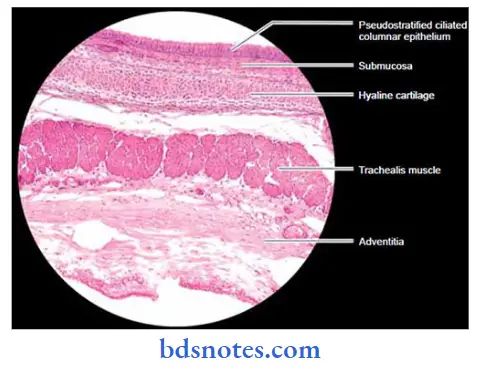
Question 3. Histology of Bone
Answer:
- It is a modified connective tissue
- It consists of Bone cells
- Histology of bone They are:
- Osteocytes
- They are widely separated by Intercellular substance
- This Intercellular substance consists of ground substance composed of Collagen fibres & mineral salts
- They lie in lacunae
- Contains eosinophilic cytoplasm
- It decreases with age
Functions: - Maintain the integrity of the lacunae & canaliculi
- Help in removal or deposition of matrix & calcium
- Osteoblasts
- These are bone forming cells
- They are present lining growing surfaces of bone
- There are numerous gaps between adjacent cells
- Nucleus is ovoid & euchromatic
- Cytoplasm is basophilic
Functions: - Lay down organic matrix of bone
- Responsible for calcification of the matrix
- Help to shed off matrix vesicles
- Inhibit or stimulate Osteoclasts
- Osteoclasts
- They are bone resorbing cells
- They are present over the resorptive surface of bone
- They occupy bays called lacunae of Howship
- They have numerous nuclei
- They are derived from monocytes of blood
- Osteoprogenitor cells
- They are precursor of osteoblasts & osteoclasts
- They resembles fibroblasts in appearance
- In fetus it is present at the site of bone formation
- In adults present over bone surfaces
- Bone lining cells
- They form a continuous epithelium like layer on bony surfaces They are flattened cells
- They are present on both periosteal & endosteal surfaces
- Osteocytes
Histology of bone Classification:
1.
- Lamellar bone
- Woven bone
2.
- Compact bone
- Cancellous bone

B Pharmacy Question Bank
Question 4. Histology of Skeletal Muscle
Answer:
- The muscle present in relation to bony skeleton is called skeletal muscle
- Histology of skeletal muscle It is made up of
-
- Muscle fibres
- They are long & cylindrical
- They are arranged in bundles called fasciculi
- Each muscle fibre is covered by a plasma membrane called sarcolemma
- They contain:
- Nucleus
- Elongated nucleus arranged along periphery
- Cytoplasm
- It is called sarcoplasm
- It contains usual cell organelles present near the nucleus
- It also contains myofibrils
- These fibrils are arranged in groups called the fields of Conheim
- Between the myofibrils there is presence of membrane lined tubes called sarcoplasmic reticulum
- Size of fibres:
- Length30 cm
- Diameter 10 to 60 micrometer
- Nucleus
- Muscle fibres
- Skeletal Muscle Connective tissue
- It supports & unites muscle fibres
- The connective tissue surrounding individual muscle fibre is called endomysium
- The connective tissue surrounding individual fasciculi is called perimysium
- Finally the connective tissue surrounding the entire muscle is called the epimysium
Striations: - The skeletal muscle shows prominent transverse striations
- These striations on staining shows alternate dark & light bands
- A band
- It is dark band
- I band
- Light band of muscle
- Z band
- It is a thin dark line present between I band
- H band
- It is lighter band present between A band
- M Band
- Thin dark line present in center of H band
- The part present between two consecutive Z bands is called Sarcomere.
- A band
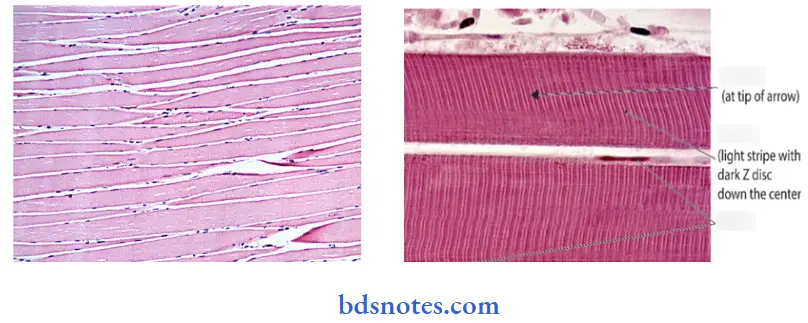
B Pharmacy Question Bank
Question 5. Histology of Medium Sized Artery
Answer:
- The blood vessels that take blood from heart to various tissues are called arteries
- The wall of medium sized artery is made up of:
- Tunica intima
- It is innermost layer
- Fibres in this layer runs longitudinally
- Histology of medium sized artery It consists of:
- An endothelial lining
- It is smooth lining which is sensitive to alterations in blood pressure
- Basal lamina
- It is thin layer of glycoprotein lining external portion of endothelium
- Delicate layer of endothelial connective tissue
Internal elastic lamina - It is a membrane formed by elastic fibres
- An endothelial lining
- Tunica media
- It is middle layer
- It consists of elastic tissue or smooth muscle
- It may also contain some connective tissue
- Fibres in this layer are circularly arranged
- On outside of this layer, a membrane is formed of elastic fibres called external elastic lamina
- Tunica adventitia
- It is outermost layer
- It consists of connective tissue with predominate collagen fibres
- These fibres are arranged longitudinally
- This layer prevents undue stretching or distension of artery
- Tunica intima
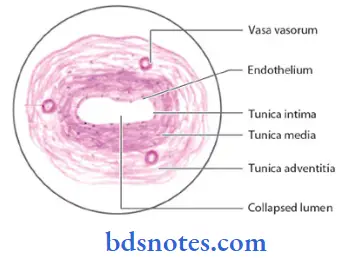
Question 6. Histology of Lymph Node
Answer:
- They are small beanshaped structures scattered along the course of lymphatic vessels
- Its concavity constitute a hilum for entry & exit of blood vessels
- Histology of medium sized artery It consists of:
- Connective tissue framework
- Interstitial spaces of it is filled with lymphocytes & other cells
- Lymph node is surrounded by a capsule
- It consists of mainly collagen fibres & some elastic fibres & smooth muscle
- Remaining part of lymph node contains reticular fibres
- Each lymph node is divided into lobules by septa or trabeculae that extendsfrom capsule into the node
- Cells
- Lymphocytes
- Lymphocytes present in blood are of two types
- BLymphocytes
- It divides rapidly
- Matures into plasma cells
- Functions:
- Remain in lymph node as memory cells & produce plasma cells
- Return to blood stream via lymph
- Concern with humoral immunity
- T-Lymphocytes
- Present in between the lymphatic nodules
- Concern with cellmediated immunity
- BLymphocytes
- Lymphocytes present in blood are of two types
- Fibroblasts
- Spindle shaped cell
- Present along reticular fibres
- Macrophages
- Present in lymph sinuses & around germinal center
- More in medulla than in cortex
- Help in phagocytosis
- Endothelial cells
- Present lining the blood vessels of lymph node
- Pericytes & smooth muscle cells
- Present around the blood vessels
- Lymphocytes
- Connective tissue framework
Histology of medium sized artery Zones:
- Cortex
- Outermost zone
- Contains densely packed lymphocytes
- It is darkly stained
- Several rounded areas called lymphatic follicles or nodules are present
- Each nodule contains a germinal center surrounded by densely packed lymphocytes
- Medulla
- It is lighter zone surrounding cortex
- Contains fewer lymphocytes
- These lymphocytes are arranged in the form of branching
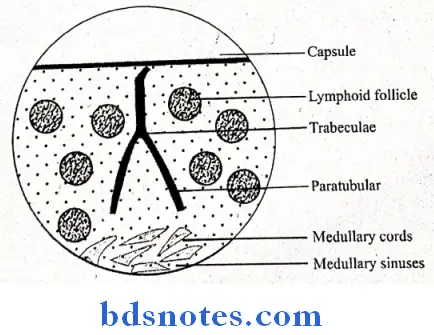
B Pharmacy Question Bank
2. Histology of medium sized artery Lymphocytes
- Present in the cortex of each lobules as densely packed
- Less densely packed in medulla of lobule
3. Histology of medium sized artery Macrophages
- Placed subjacent to the capsule at corticomedullary junction & in the medulla
Functions: - Phagocytosis
- Deeper cells are dendritic
4. Histology of medium sized artery Corpuscles of Hassall
- They are small rounded cells
- Present in medulla

Question 7. Histology of Lung
Answer:
- The lung is divided into numerous lobules
- These lobules are obtained by following branching
Histology of lung Branching:
- Principal bronchus divides into secondary or lobar bronchi
- Each lobar bronchi divides into tertiary or segmental bronchi
- Each segmental bronchi divides into smaller bronchi that end in bronchioles
Histology of lung Changes seen in subsequent branching:
- Cartilage becomes irregular
- Amount of muscle increases
- Subepithelial lymphoid tissue increases
- Epithelial changes occur from pseudostratified to cuboidal epithelium
Histology of lung Structure of lung:
- The lung is divided into numerous lobules
- These lobules receives lobular bronchiole
- Lobular bronchiole divides into terminal bronchiole
- Each terminal bronchiole ends into respiratory bronchiole Each respiratory bronchiole ends into alveolar ducts
- Each alveolar duct ends into atrium which leads to alveolar sacs
- Each alveolar sac contains alveoli
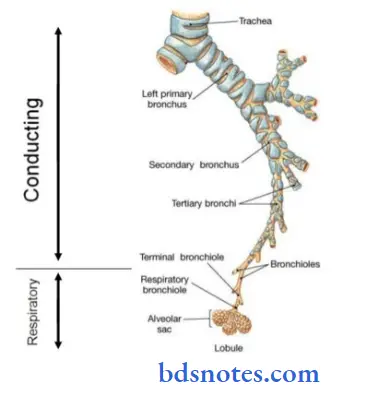
B Pharmacy Question Bank
Question 8. Histology of Parotid Gland
Answer:
- In the parotid gland the spherical secretory end peices are all serous
- The pyramidal shaped acinar cells have a spherical, basally situated nucleus
- It surrounds a small, central lumen
- It may contain fat cell spaces
Histology of parotid gland Ducts:
1. Intercalated ducts
- They are numerous & long
- They are lined with cuboidal epithelium
- Nuclei of myoepithelial cells may appear
2. Striated ducts
- They are numerous
- They are round or elongated tubules
- It consists of simple columnar epithelium
- Nuclei are round & centrally placed
- Lumina are relatively larger in size
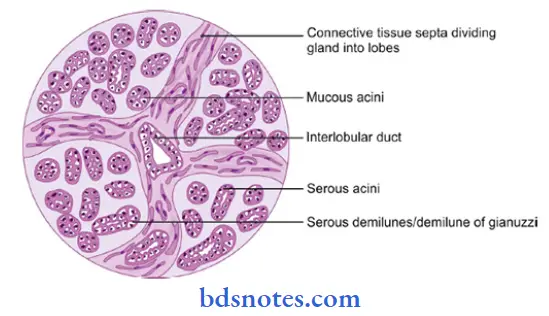
Question 9. Histology of Esophagus
Answer:
- Oesophagus is a tube
- Histology of esophagus It has four layers
- Mucosa
- It shows several longitudinal folds that disappear when the tube is distended It is lined by stratified Squamous epithelium
- Finger like processes project from connective tissue into the epithelium
- This prevents separation of epithelium
- Lamina propria contains some mucous glands
- The muscularis mucosae is absent or poorly developed
- Submucosa
- It contains compound tubuloalveolar mucous glands
- These glands are present at the level of bifurcation of the trachea
- Muscle layer
- It consists of usual circular & longitudinal layers
- External adventitia
- It is dense fibrous tissue surrounding the muscle layer
- Mucosa
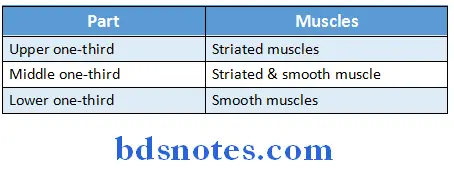
B Pharmacy Histology Solutions
Question 10. Histology of Kidney
Answer:
Histology of kidney External structure:
- It is a bean shaped structure
- Its convex margin is placed laterally while concave margin is placed medially forming hilum
- Hilum leads into renal sinus
- Renal sinus is occupied by the upper expanded part of the ureter called renal pelvis
- Renal pelvis divides into
- Major calyces
- Minor calyces
- Each major calyx divides into it
- Papilla
- It is a projection of kidney tissue
Histology of kidney Internal structure:
- Kidney consists of
- Inner part called medulla
- It consists of triangular areas called renal pyramid
- Base of it is directed towards cortex & apex towards renal pelvis
- Outer part called cortex
- It consists of
- Cortical arches/lobules
- It is the tissue lying between the base of the pyramid & surface of the kidney
- Renal columns
- It is the tissue lying between adjacent pyramids
- Cortical arches/lobules
- It consists of
- Inner part called medulla
Histology of kidney Lobe of kidney:
- Pyramid & the cortex around it constitute lobe
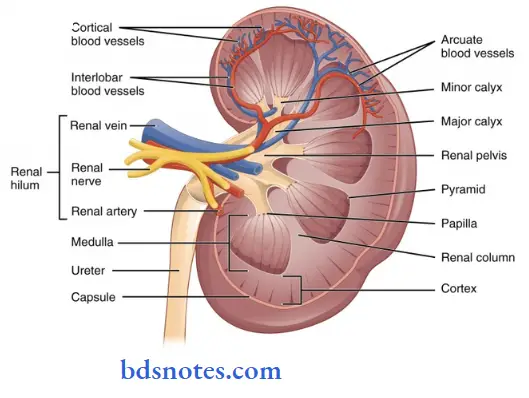
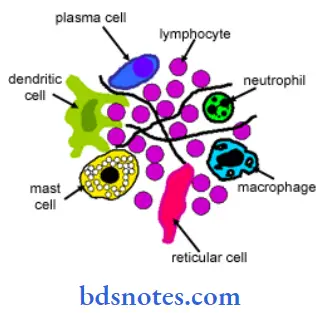
Question 11. Histology of Thymus
Answer:
- Thymus consists of right & left lobes joined by fibrous tissue
- Each lobe is about 2 mm in diameter
- It has outer cortex & inner medulla
- Each lobe has
- Capsule
- Made up of connective tissue
- Septa
- It passes from capsule which incompletely divides the lobe into lobules
- Capsule
Cells of Thymus:
- Epithelial cells called epitheliocytes
- They are flattened cells
- They join to form sheets covering internal surface of capsule, surfaces of septa & surfaces of blood vessels
- They lie deep in the lobule
Functions: - Prevents antigen present in blood from reaching lymphocytes in thymus
- Promotes Tcell differentiation & proliferation
Question 12. Histology of Hypophysis Cerebri
Answer:
- It is also called Pituitary gland
- It has been divided into
- Anterior part pars anterior
- Intermediate part pars intermedia
- Posterior partpars posterior
- Pars posterior & infundibular stalk together forms neurohypophysis
- Pars anterior & pars intermedia forms adenohypophysis
Histology of hypophysis cerebriv Adenohypophysis:
Histology of hypophysis cerebri Pars anterior:
- It consists of cords of cells separated by Sinusoids
- It consists of following cells
- Chromophil
- Contains brightly stained granules
- It is further classified into
- Chromophil
Histology of hypophysis cerebri Acidophil or Alpha Cells:
Alpha Cells Types:

Histology of hypophysis cerebri Basophil or beta cells:
Beta Cells Types:
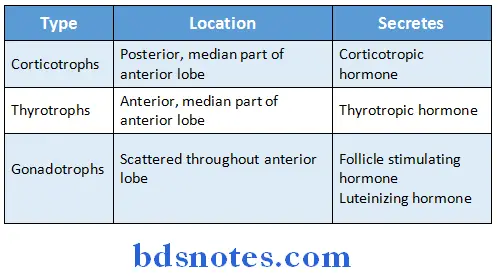
2. Chromophobe cells
- Contains very few granules
Pars tuberalis:
- Histology of hypophysis cerebri Pars tuberalis Consists of:
- Undifferentiated cells
- Acidophil
- Basophil
Pars intermedia:
- It is poorly developed
- Contains colloid filled vesicles
- Some cells produce melanocyte stimulating hormone
Pars intermedia Cells:
- Beta cells
- Secretory cells
- Chromophobe cells
Pars intermedia Neurohypophysis:
Pars intermedia Pars posterior:
- It consists of numerous Unmyelinated nerve fibres
- These are axons of neurons
- There are supporting cells called Pituicytes between these axons
- These cells have long dendritic processes
- The pars posterior is associated with the release of
-
- Vasopressin
- Oxytocin
Question 13. Histology of Thyroid
Answer:
- It is covered by a fibrous capsule
- Septa extends from capsule into gland substance & divides it into
lobules - Each lobule is made up of follicles
- Follicle has a cavity filled with colloid
- Each follicle consists of
- Cells:
- Follicular cells
- They line the follicles
- They secrete T3 & T4 hormones They contains
- Golgi complex
- Lysosomes
- Microtubules
- Microfilaments
- Secretory vacuoles
- They vary in shape according to their activity
- Normally Cells are cuboidal with moderate colloid
- Inactive cell are flat with abundant colloid
- Highly active cell are columnar with scanty colloid
- Follicular cells
- C cells or parafollicular cells
- They are polyhedral cells with oval nuclei
- Cells:
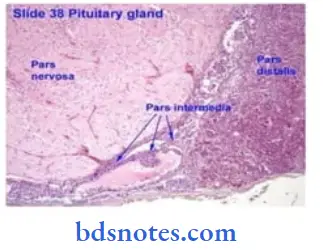
Histology of thyroid Location:
- In between follicular cells & basement membrane.
- In connective tissue between the follicles
Histology of thyroid Contains:
- Granular endoplasmic reticulum
- Golgi complex
- Mitochondria
- Membrane bound Secretory granules
Hormone secreted: - Thyrocalcitonin
2. Connective tissue stroma
- It surrounds the follicles
- It contains capillary plexus, lymphatic capillaries & sympathetic nerves
Question 14. Histology of Suprarenal Gland
Answer:
- It is also called adrenal gland
- It is covered by connective tissue capsule
- Septa extends from capsule and divides the gland substance
Histology of Suprarenal Gland Parts:
- Cortex:
- It is made up of cells arranged in cords
- Sinusoids intervene between the cords
- Layers:
- Zona glomerulosa
- Outermost layer
- Consists 1/5th of cortex
- Cells are arranged as inverted U shape
- Zona fasciculata
- Cells are arrange in straight columns
- Sinusoids intervene between columns
- Consists 3/5th of cortex
- Zona reticularis
- Consists 1/5th of cortex
- Made up of cords that branch and anastomose
- Zona glomerulosa
-
- Secretions:
-
-
- Aldosterone and deoxycorticosterone by cells of zona glomerulosa
- Cortisone and cortisol by cells of zona fasciculata
- Glucocorticoids and sex hormones by cells of zona reticularis
-
- Medulla:
- Cells shows yellow cytoplasm
- Cells are columnar
- Arranged in columns which are separated by wide sinusoids
- Cytoplasm is basophilic
- Secretions:
- Secretes adrenaline and non adrenaline
Question 15. Histology of Large Sized Artery
Answer:
- Large sized arteries include the aorta, carotid arteries, subclavian, axillary, iliac artery
- The wall of it is made up of
- Tunica intima
- It is innermost layer
- It consists of
- An endothelial lining
- Thin layer of glycoprotein called nasal lamina
- Subendothelial connective tissue containing elastic fibres
- In it internal elastic lamina is not distinct as in medium sized artery
- Tunica media
- It is made up of mainly elastic tissue
- This tissue is arranged in the form of series of concentric membranes
- Between these membranes there is presence of loose connective tissue
- This layer is limited outside by external elastic lamina made up of elastic fibres
- Tunica adventitia
- It is relatively thin containing large amount of elastic fibres
- These fibres merge with the external elastic lamina
- Tunica intima
Question 16. Histology of Spleen
Answer:
- The surface of spleen is covered by a layer of periosteum
- Capsule occurs below it
- It is made up of fibrous tissue with abundant elastic tissue
- Trabeculae extends from the capsule and divides the substance into smaller divisions forming a network
- Spaces between the trabeculae contains a network of reticular fibres
- Cells present in reticulum are.
- Fibroblasts
- Macrophages
- Lymphocytes
- Blood vessels
- Splenic artery enters the trabeculae and divides into arterioles
- Each arterioles is surrounded by lymphocytes
- This constitute white pulp of spleen
- Blood flows into the spaces lined by reticular cells due to the adherence of the dilated portion of vesszi called ampulla with reticular cells
- The part of spleen which contains blood is called red pulp of spleen
- Blood from red pulp is collected by wide sinusoids to drain
- These sinusoids are lined by modified endothelium
- These endothelium cells are shaped like banana and known as stave cells
- These cells contains fibrils which help the cells to change their shape as per requirement
- Thus spleen consists of two parts
- White pulp
- Red pulp
Question 17. Histology of Submandibular Gland
Answer:
- Submandibular gland is a mixed salivary gland
- It contains both serous and mucous acini
- Serous cells:
- They are darkly stained
- Have rounded nuclei placed towards the base
- They are arranged in the form of rounded acini or roughly pyramid
- Base is towards basement membrane and apex towards lumen
- Apex shows microvilli and pinocytotic vesicles
- Lumen has intercellular secretory canaliculi
- Cytoplasm contains
- Small and homogenous secretory granules Prominent Golgi apparatus
- Abundant rough endoplasmic reticulum Mitochondria
- Lysosomes
- Microfilaments
- Mucous cells:
- They are lightly stained
- Nucleus is flattened and present towards the basement membrane
- Cells are arranged in form of tubules
- Cells lining the tubules are columnar
- Secretory granules are large and ill defined
- Demilunes/Crescents:
- These are mucous cells covered by serous cells
- They are present at the ends of mucous tubules
- Serous cells:
Question 18. Histology of Cartilage
Answer:
- Cartilage is modified connective tissue
- Histology of cartilage It consists of
- Cartilage cells called chondrocytes
- They lie in lacunae
- Matrix
- It consists of homogeneous ground substance within which fibres are embedded
- Ground substance
- Made up of complex molecules containing proteins & carbohydrates
- Fibres
- Chiefly composed of Type II collagen fibres
- Ground substance
- It consists of homogeneous ground substance within which fibres are embedded
- Cartilage cells called chondrocytes
Question 19. Name the four sites where Hyaline Cartilage is present
Answer:
- Hyaline cartilage is present in the following
- Costal cartilage connecting ends of ribs to sternum.
- Articular cartilage present over articular surfaces of synovial joints
- Skeletal framework of larynx
- Wall of trachea & large bronchi
- Parts of nasal septum & lateral wall of nose
- Connecting epiphysis to diaphysis in bones of growing children
Question 20. Microscopic structure of Hyaline Cartilage
Answer:
- Hyaline cartilage is transparent so called hyaline cartilage
- Microscopic structure of hyaline cartilage It consists of:
- Intercellular substance
- It is homogeneous
- Matrix
- It prevents separation of cells
- Helps to maintain them in groups called cell nests
- Ground substance
- It resists compressive forces
- It contains collagen fibres which resists tensional forces
- Intercellular substance
Question 21. Histology of Elastic Cartilage
Answer:
- Its matrix contains numerous elastic fibres
- These fibres are arranged in a network
- They are viewed using special stains
- The surface of elastic cartilage is covered by perichondrium
- Elastic cartilage is seen in following sites:
- Skeletal basis of auricle
- Lateral part of external acoustic meatus
- Wall of medial part of auditory tube
- Epiglottis & two small laryngeal cartilages
- Apical part of arytenoid cartilage
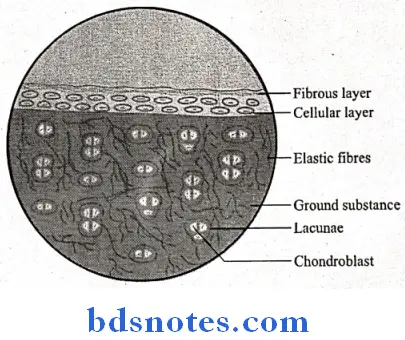
Question 22. Histology of Compact Bone
Answer:
- Compact bone is made up of lamella
- These lamellae are arranged in concentric rings surrounding narrow
- Haversian canal
- Canal runs along the length of the bone
- These canals branch & anastomose with each other
- They also communicate with the marrow cavity & with the external surface of bone through channels called the canals of Volkmann
- This canal is occupied by blood vessels, nerve fibres & some cells
- Together Haversian canal & lamellae constitute Haversian system, also called osteon
- Compact bone consists of many such osteons separated by interstitial lamellae
- Near its surface lamellae are arranged parallel to the surface called circumferential lamellae
Question 23. What are different types of Epiphysis?
Answer:
- Pressure epiphysis
- These epiphysis are articular
- They take part in joint formation
- Example: Head of humerus, lower end of radius, etc.
- Traction epiphysis
- These epiphysis are non articular & so donot take part in joint formation
- It provides attachment to tendons of muscle
- Example: Tubercles of humerus
- Atavistic epiphysis
- They are independent but they become fused
- Example: coracoid process of scapula
- Aberrant epiphysis
- They are unusual
- Example: Epiphysis at the head of the 1st metacarpal bone & at the base of other metacarpal bone
Question 24. Draw & label a T.S. of an Osteon (or) Draw a well labelled diagram of Histology of thymus
Answer:
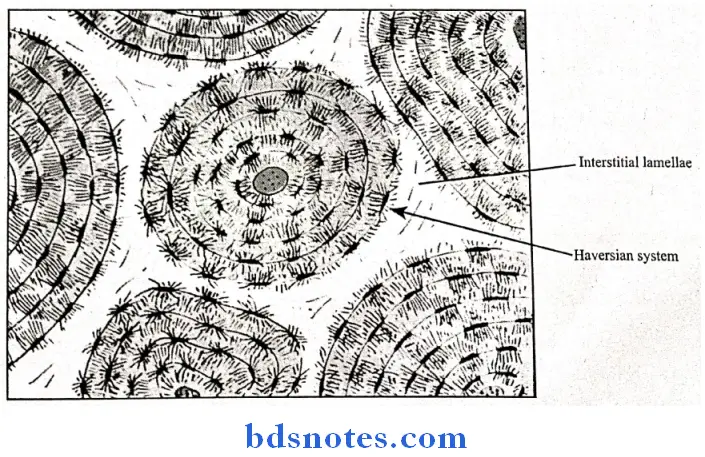
Question 25. Haversian system (or) Histology of parotid gland
Answer:
- The compact bone is made up of lamellae
- These lamellae are arranged in concentric rings surrounding narrow
- Haversian canal
- This canal is occupied by blood vessels, nerve fibres & some cells
- Together Haversian canal with lamellae constitute Haversian system
Question 26. Histology of Bone
Answer:
- Bone is a modified connective tissue
- Histology of bone It consists of:
- Osteocytes
- They are widely separated by Intercellular substance
- They lie in lacunae of bone
- Osteoblasts
- They are bone forming cells
- They are found lining surfaces of growing bone
- Osteoclasts
- They are bone resorbing cells
- They are found over surfaces where bone removal is taking place
- Osteoprogenitor cells
- They resembles fibroblasts
- Bone lining cells
- They are flattened cells present over bony surfaces
- Osteocytes
Question 27. Histology of large sized artery. (or) Histological appearance of elastic artery
Answer:
- Elastic arteries or largesized arteries include the aorta, carotid arteries, subclavian, axillary, iliac artery
- The wall of it is made up of:
- Tunica intima
- Subendothelial connective tissue contains more elastic fibres
- Internal elastic lamina is not distinct
- Tunica media
- It is made up of mainly of elastic tissue
- This tissue is in the form of a series of concentric membranes
- Between these membranes there is presence of loose connective tissue
- Tunica adventitia
- It is relatively thin containing large amount of elastic fibres
- These fibres merge with the external elastic lamina
- Tunica intima
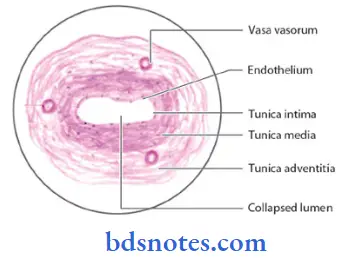
Question 28. Microscopic Structure of Spleen
Answer:
It is covered by a layer of peritoneum
- Capsule is present below it
- It is made up of fibrous tissue with abundant elastic fibres
- Trabeculae arises from the capsule & divides it into small divisions forming a network
- Lymph vessels are confined to the capsule & trabeculae
- Spaces between the trabeculae contains a network of reticular fibres
Cells present in reticulum:
- Fibroblasts
- Macrophages
- Lymphocytes
- Blood cells
Question 29. Histology of Lymph Node
Answer:
- They are small beanshaped structures scattered along the lymphatic vessels
- Lymph node is surrounded by capsule composed mainly of collagen fibres
- Lymph node consists of
- Connective tissue framework
- Cells
- L-ymphocytes
- B-Lymphocytes
- T-Lymphocytes
- Macrophages
- Fibroblasts
- Endothelial cells
- Pericytes & smooth muscle cells
- L-ymphocytes
Histology of lymph node Zones:
-
- Cortex-Outermost zone
- Medulla-Surrounding cortex
Question 30. Histology of Thymus
Answer:
- Thymus consists of right & left lobes joined by fibrous tissue
- Each lobe is about 2 mm in diameter
- It has outer cortex & inner medulla
- Each lobe has
- Capsule
- Septa
Histology of thymus Cells of thymus:
- Epithelial cells called epitheliocytes
- Lymphocytes
- Macrophages
- Corpuscles of Hassall
Question 31. Microscopic anatomy and development of Tonsil
Answer:
- It consists of diffuse lymphoid tissue containing lymphatic nodules
- It is covered by stratified Squamous epithelium
- This epithelium extends into tonsil forming several tonsillar crypts
Microscopic anatomy and development of tonsil Crypts:
- It contains numerous mucous glands
- It contains cells like
- Lymphocytes
- Desquamated epithelium cells
- It also contains bacteria
Microscopic anatomy and development of tonsil Development:
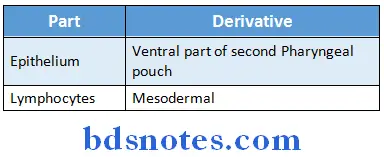
Question 32. Microscopic structure of Trachea
Answer:
- It is made up of 16-20 tracheal cartilages
- The intervals between the cartilages are filled by fibrous tissue
- Gaps between cartilage end are filled in by smooth muscle & fibrous tissue
- Connective tissue in the wall contains many elastic fibres
Microscopic structure of Trachea Lumen:
- Lined by mucous membrane
- It consists of
- Epithelium
- It is pseudostratified ciliated columnar
- Microscopic structure of trachea It contains:
- Goblet cells
- Basal cells
- Lymphocytes
- Connective tissue contains
- Elastic fibres
- Serous & mucous glands
- Lymphoid tissue
- Eosinophil, leucocytes
- Epithelium
Question 33. Histology of Submandibular Gland
Answer:
- Submandibular gland contains serous end peices & mucous tubules
- Serous end peices contains abundant secretory granules, spherical nucleus & basophilic cytoplasm
- Mucous secretory cells are filled with pale staining secretory material & little cytoplasm
- Its nucleus is compressed & contains densely stained chromatin
- The lumina of mucous tubules are larger
- The Intercalated & Striated ducts are less in number
- Connective tissue septa Mucous acini
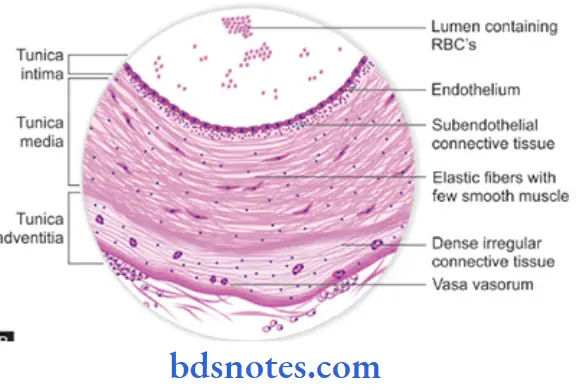
Question 34. Histology of Liver
Answer:
- The liver is covered by capsule made up of connective tissue
- The liver substance is divided into large number of lobes consisting of numerous hepatic lobules
- The lobules appear to merge with one another
- Each lobule is made up of liver cells called hepatocytes
- These cells are large with round openfaced nuclei & prominent nucleoli
- They are separated by sinusoids
- Sinusoids are surrounded by reticular fibres
- Along the periphery of each lobules, there are angular intervals called portal canals
- Each canal contains
- Branch of portal vein
- Branch of hepatic artery
- Interlobular bile duct
- These structures collectively form portal triad
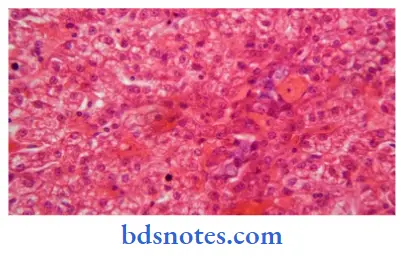
Question 35. Histology of pancreas (or) Islets of Langerhans
Answer:
- It is partly exocrine & partly endocrine gland
- Exocrine part
- A delicate capsule surrounds the pancreas
- Septa extends from capsule into the gland & divides it into lobules
Secretory elements are long & tubular - The lining cells are triangular with spherical nuclei
- Cytoplasm is basophilic & contains zymogen granules
- Endocrine part
- It consists of numerous collection of cells called islets of Langerhans
- Each islets is separated from the surrounding alveoli by a thin layer of reticular tissue
- Exocrine part
. Histology of pancreas Types:
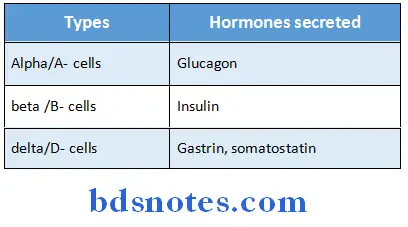
Question 36. Histology of Kidney
Answer:
Histology of kidney External structure:
- It is a bean shaped structure
- Its convex margin is placed laterally while concave margin is placed medially forming hilum
- Hilum leads into renal sinus
- Renal sinus is occupied by the upper expanded part of the ureter called renal pelvis
- Renal pelvis divides into
- Major calyces
- Minor calyces
- Papilla
Histology of kidney Internal structure:
- Kidney consists of
- Inner part called medulla 2 Outer part called cortex
Question 37. Histology of Pituitary Gland
Answer:
- It is also called hypophysis cerebri
- It has been divided into
- Anterior partpars anterior
- Intermediate partpars intermedia
- Posterior partpars posterior
- Pars posterior & infundibular stalk together forms neurohypophysis
- Pars anterior & pars intermedia forms adenohypophysis
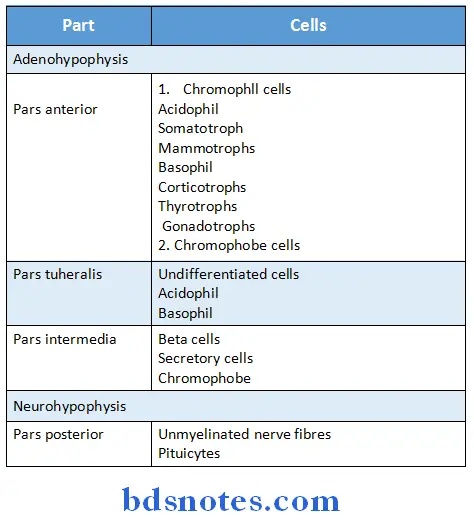
Question 38. Adrenal Cortex Zone Fasciculatum
Answer:
- It is the middle layer of Suprarenal cortex
- It forms middle 3/5th of the cortex
Adrenal cortex zone fasciculatum Cells:
- They are arranged in straight columns
- Sinusoids intervene between them
- Cells are large, polyhedral
- Contains basophilic cytoplasm & vesicular nuclei
- They are rich in lipids & vitamin C
- They produce glucocorticoids
Question 39. Parathyroid glands
Answer:
- It is covered by a connective tissue capsule
- Septa extends from capsule & divides the gland substance
Arathyroid glands Cells:
1. Chief cells or principal cells
- They are numerous
- They are smaller in size
- Contains clear cytoplasm & vesicular nuclei
- They produce parathyroid hormone
Types: - Light
- Dark
- Clear
2. Oxyphilic/ eosinophilic cells
- They are absent in the young
- They are larger in size
- Contains granules in cytoplasm
- Nucleus is small & stains intensely
Question 40. Microscopic picture of Suprarenal Gland
Answer:
- Suprarenal gland is also called adrenal gland
- It is covered by a connective tissue capsule
- Septa extends from capsule & divides the gland substance
Microscopic picture of suprarenal gland Parts:
1. Superficial part called cortex
- It is made up of cells arranged in cords
- Sinusoids intervene between the cords
Layers: - Outermost layer called zona glomerulosa
- Next zone called zona fasciculata
- Innermost layer called zona reticularis
2. Deeper part called medulla
- Its cells shows yellow granules in the cytoplasm
- The cells are columnar
- Cytoplasm is basophilic
- They secrete noradrenaline & adrenaline
Question 41. Give the microscopic structure of Developing tooth Collagen Fibres Golgi apparatus
Answer:
Developing tooth Collagen fibres Golgi apparatus Developing tooth:
- The epithelium in relation to the alveolar process thickens to form dental lamina
- The cells of dental lamina proliferate at various sites to form enamel organ
- This enamel organ grows into underlying mesenchyme & assumes cup shaped appearance
- The mesenchyme is of neural crest origin & is called dental papilla
- The dental papilla alongwith enamel organ is called tooth germ
- This stage is called ‘cap stage’
- The cells of enamel organ adjacent to dental papilla becomes columnar & are known as ameloblasts
- The mesenchymal cells adjacent to ameloblasts differentiate into odontoblasts
- The two cell layers are separated by a basement membrane
- Rest of mesenchymal cells form pulp
- This is called ‘bell stage’
- Ameloblasts lay down enamel & odontoblasts lay down dentin
- The root of the tooth is formed by laying down of layers of dentin & narrowing the pulp space
- The root dentin is covered by mesenchymal cells that differentiate into cementoblasts
- These cementoblasts lay down cementum
Developing tooth Collagen fibres Golgi apparatus Collagen fibres:
- Each collagen fibre is made up of fibrils of diameter 20200 nm
- Each fibrils shows cross striations
- Each fibrils contains numerous myofibrils
- Size of each collagen fibre is about 112 micrometer in diameter They are arranged in groups
Developing tooth Collagen fibres Golgi apparatus Types:
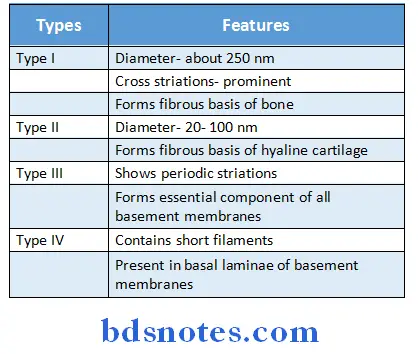
Developing tooth Collagen fibres Golgi apparatus Golgi apparatus:
- It is small, irregular structure
Developing tooth Collagen fibres Golgi apparatus Location:
- Usually near the nucleus
Developing tooth Collagen fibres Golgi apparatus Structure:
- It is made up of membranes
- Membranes form the walls of a number of flattened sacs that are placed over one another
- Towards the margins there are small rounded vesicles
Developing tooth Collagen fibres Golgi apparatus Regions:
- Functionally, Golgi apparatus is divided into 3 regions
1. Cis face/ Cis Golgi
- It is a region near to the nucleus
2. Trans face/ Trans Golgi
- It is a region near cell membrane
3. Intermediate part
- It is present between cis & trans face
Question 42. Microscopic picture of endochondrial ossification
Answer:
- Following changes occurs during endochondrial ossification
- Mesenchymal cells are closely packed to form Mesenchymal condensation
- Some of them differentiate into chondrocytes & lay down hyaline cartilage
- Cells of this cartilage are
- Initially-small & irregular
- Later-Enlarges
- Next, due to lack of nutrition, cells die forming empty spaces called primary areolae
- This is later destroyed by the blood vessels of perichondrium & results in secondary areolae
- Osteoprogenitor cell invade it & becomes osteoblasts
- Osteoblasts lay down a layer of osteoid
- Osteoid is calcified & forms lamellus of bone
- Similarly, osteoblasts lay down another layer of lamellus which gets calcified
- Some osteoblasts are entrapped between the two lamellae & becomes osteocytes Osteocyte
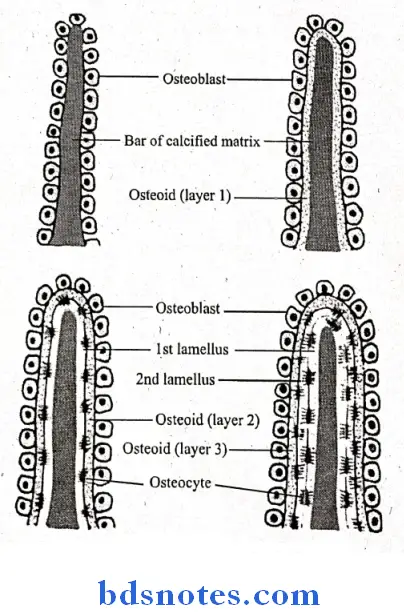
Question 43. Histology of skeletal muscle
Answer:
- The muscle present in relation to bony skeleton is called skeletal muscle
- Histology of skeletal muscle It is made up of:
-
- Muscle fibres
- They are long and cylindrical
- They are arranged in bundles called fasciculi
- Each muscle fibre is covered by a plasma membrane called sarcolemma
- Connective tissue
- It supports and unites muscle fibres
- Muscle fibres
Histology of skeletal muscle Striations:
- Skeletal muscle section on staining shows alternate dark and light band
-
- A band dark band
- I band-light band
- Z band-dark line between I band
- H band-light line between A band
- M band dark line in center of H band
- Part present between two consecutive Z bands is called sarcomere.
Question 44. Primary cartilaginous joint
Answer:
- Primary cartilaginous joints are also known as synchondroses
- These bones are connected by hyaline cartilage
- Sometimes occur between ossification centres
- This cartilage may ossify with age
- Such joints allow only a little movement such as in spine and ribs.
Question 45. Histology of thyroid gland
Answer:
- Thyroid gland is covered by fibrous capsule
- Septa extends from capsule into gland substance and divides it into lobules
- Each lobule is made up of follicles
- Follicle has a cavity filled with colloid
- Each follicle consists of:
-
- Cells
- Follicular cells
- They line the follicle
- Secretes T3 &T4 hormones
- They vary in shape according to their activity
- C cells or parafollicular cells
- They are polyhedral in shape
- Present between follicular cells and basement membrane and between the follicles
- Follicular cells
- Connective tissue stroma
- It surrounds the follicles
- Contains capillary plexus, lymphatic capillaries and sympathetic nerves
- Cells
Leave a Reply